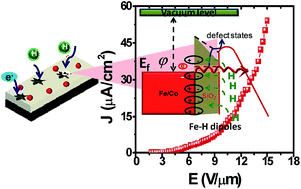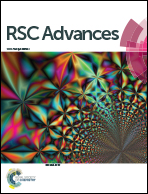Spectral weight shift in the valence band density of states and concurrent increase in field emission by hydrogenation of FeCo–SiO2 nanocomposites
Abstract
Hydrogenated and roughened surfaces of hydrogen plasma treated (HPT) FeCo–SiO2 nanogranular films are found to be efficient field emitters in comparison to their as-grown and furnace annealed counterparts. Partial etching using hydrogen plasma roughens the surface and improves the field emission by enhancing the local electric field at the protrusion tips. A layer of Feδ+–Hδ− dipoles over the roughened HPT film surface and enhanced defects are likely to make the composite surface more emission-active by reducing the overall work function. The reconstruction of the electronic structure is mainly attributed to the Fe2+ to Fe3+ conversion and the appearance of anti-bonding states. Further, hydrogen-induced volume expansion of FeCo particles improves the conductivity. Thus tunnelling of electrons from the valence band becomes easier via these inter-gap anti-bonding states. The agglomeration of nanoparticles, out-diffusion of hydrogen, and further etching of the film at a higher substrate temperature of the plasma treated films reduces the FE current density drastically.


 Please wait while we load your content...
Please wait while we load your content...